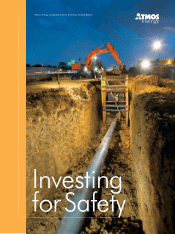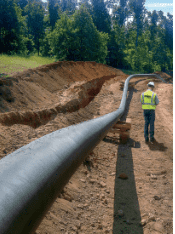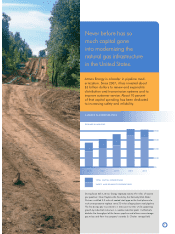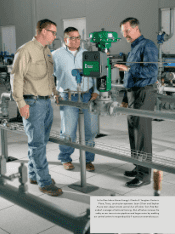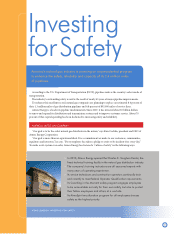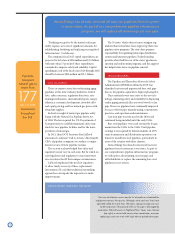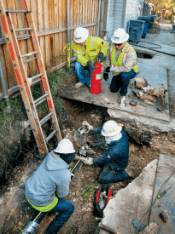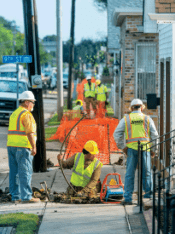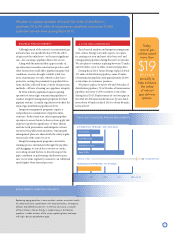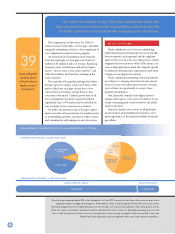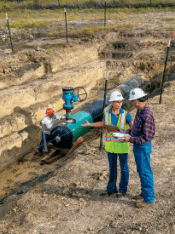Atmos Energy 2014 Annual Report Download - page 6
Download and view the complete annual report
Please find page 6 of the 2014 Atmos Energy annual report below. You can navigate through the pages in the report by either clicking on the pages listed below, or by using the keyword search tool below to find specific information within the annual report.
Pipelines
transport
natural gas to
more than
MILLION
Americans
throughout
the U.S.
Atmos Energy has already removed all cast iron pipelines from its system
in seven states. As part of our comprehensive pipeline infrastructure
program, we will replace all remaining cast iron pipe.
4
“Realizing our goal to be the nation’s safest gas
utility requires us to invest signicant amounts for
rehabilitating, fortifying and replacing our regulated
infrastructure,” Cocklin says.
e company’s scal 2015 capital expenditures are
projected to be between $900 million and $1.0 billion,
with more than 75 percent of these expenditures
earmarked to improve safety and reliability. Capital
spending in each of the scal years 2016 through 2018
should be between $900 million and $1.1 billion.
CALL TO ACTION
ere are many reasons for modernizing aging
pipelines at this time: industry initiatives, federal
laws, safety concerns, regulatory directives, rate-
making mechanisms, environmental goals, energy
eciency, economic development, favorable debt
and equity pricing, and low natural gas prices with
abundant supplies.
Federal oversight of natural gas pipeline safety
began with the Natural Gas Pipeline Safety Act
of 1968. e law required the U.S. Department of
Transportation to establish minimum safety stan-
dards for new pipeline facilities and for the trans-
portation of natural gas.
In 2011, then-DOT Secretary Ray LaHood
announced a national “Call to Action,” directing the
CEOs of pipeline companies to conduct a compre-
hensive review of their pipeline systems.
e secretary acknowledged that safety and
regulatory needs vary in each state. But he called on
state legislators and regulators to enact innovative
rate structures that t their unique circumstances.
LaHood emphasized the need for regulators
to allow timely recovery of these replacement
investments. He said that traditional ratemaking
approaches can impede the imperative to make
improvements.
e 50 states, which oen set more stringent reg-
ulations than federal laws, have stepped up their own
pipeline safety programs. e states have primary
responsibility for regulating natural gas distribution
systems and intrastate pipelines. Federal funding
provides about half the cost of the states’ pipeline in-
spection and enforcement programs, and this support
has helped states focus on pipeline renewal.
SETTING PRIORITIES
e Pipeline and Hazardous Materials Safety
Administration (PHMSA) within the DOT has
identied cast iron and unprotected bare steel pipe-
lines as the pipeline segments to begin replacing rst.
ese materials were once state-of-the-art tech-
nology, enhancing safety and reliability by displacing
earlier piping materials like creosoted wood or clay
pipe. However, pipelines have continually improved
because of better pipe manufacturing, construction
practices, and operation and maintenance.
Cast iron pipe was rst used in the 1830s and
continued being installed until the early 1950s.
Bare steel pipelines were used extensively for gas
mains from the 1900s to the 1960s. Until pipeline
coatings were required by federal mandate in 1970,
some transmission and distribution operators con-
tinued to install bare steel pipelines, particularly in
areas of the country with drier climates.
Atmos Energy has already removed all cast iron
pipelines from its system in seven states. As part of
our comprehensive pipeline infrastructure program,
we will replace all remaining cast iron pipe and
will rehabilitate or replace the remaining bare steel
pipelines in our system.
Cast iron distribution mains top the list of pipelines scheduled for
replacement across the country. Although some cast iron lines have
operated safely for more than 100 years, aging iron pipe can turn
brittle and crack if the ground shifts or the pipe is damaged by
excavation. Behind houses in Highland Park, Texas, Juan Gomez
(top right), a senior field construction coordinator, oversees
replacing a cast iron main with high-density polyethylene pipe.
ATMOS ENERGY: INVESTING FOR SAFETY
177

